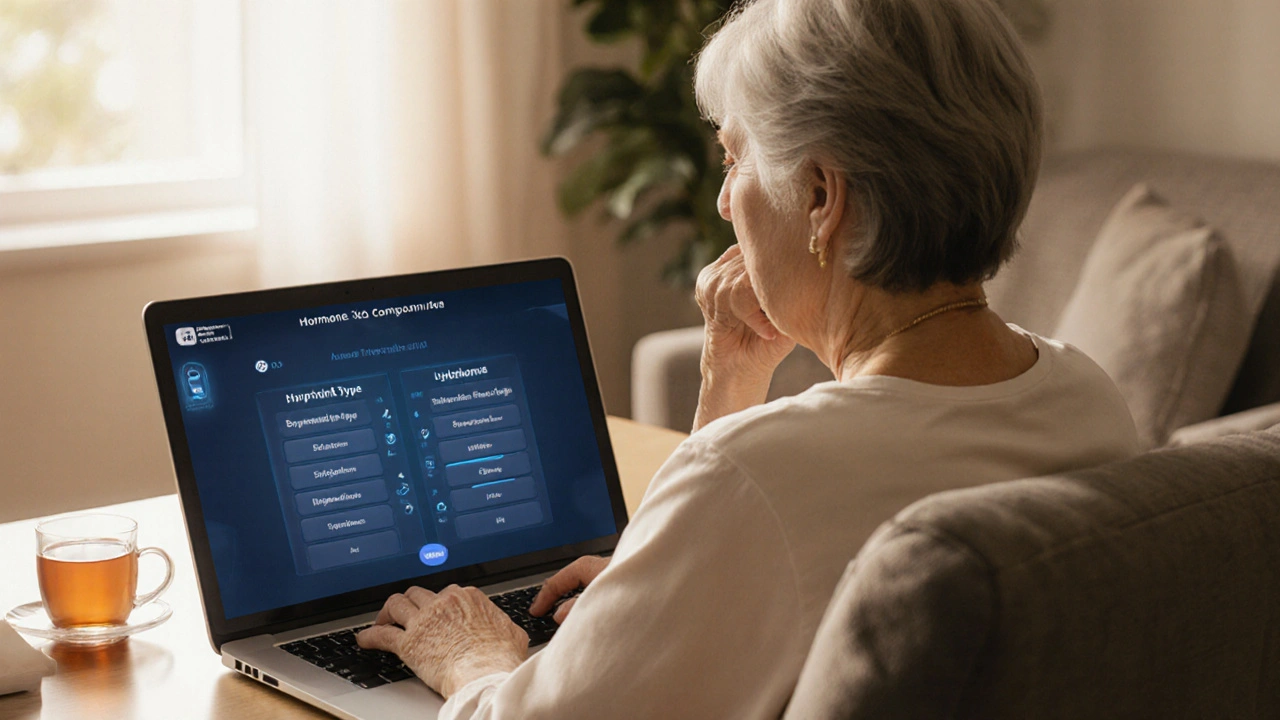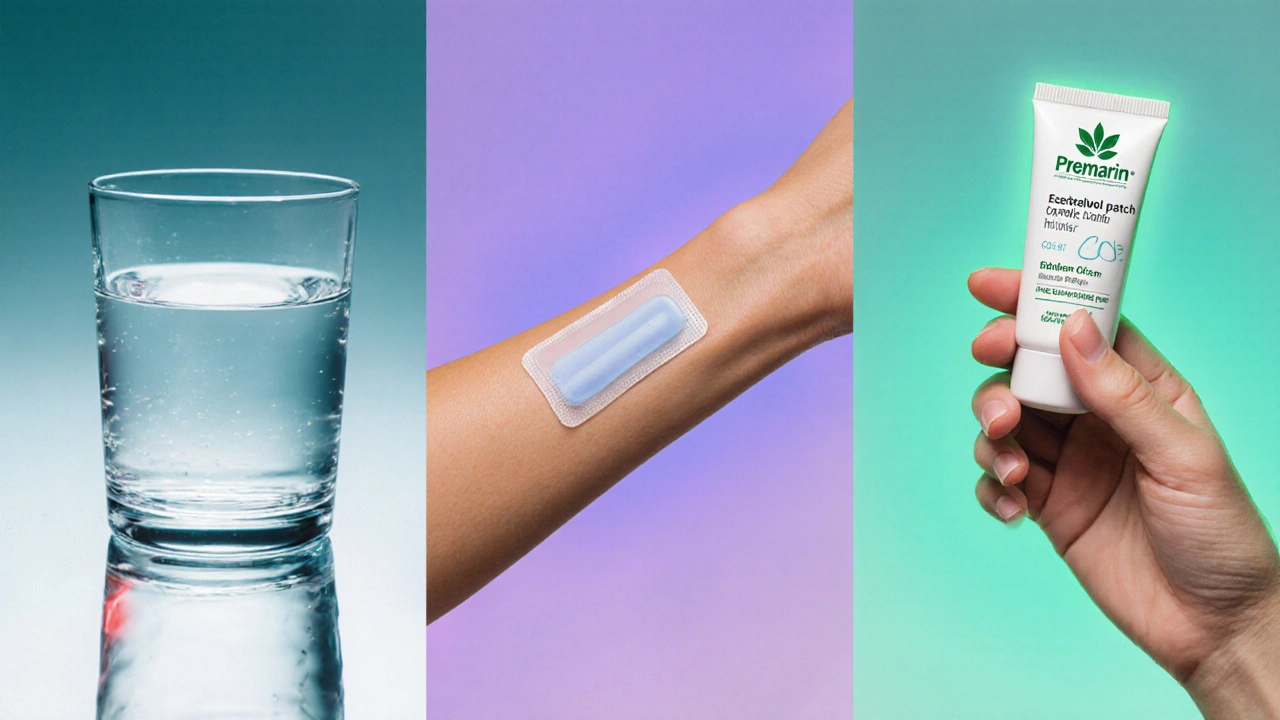
Hormone Therapy Comparison Tool
Therapy Details
Form: -
Typical Dose: -
Bioavailability: -
Major Risks: -
Average Monthly Cost: -
When it comes to menopausal hormone therapy, Premarin often shows up first in the conversation. But is it really the best fit for every woman? This guide breaks down Premarin (conjugated estrogens) side by side with the most common alternatives, so you can weigh risks, benefits, and practical considerations before making a decision.
Key Takeaways
- Premarin is a horse‑derived mixture of estrogen compounds, while most alternatives use single, bioidentical molecules.
- Transdermal estradiol patches avoid first‑pass liver metabolism, reducing clot risk compared with oral forms.
- Oral estradiol, estriol, and low‑dose bioidentical combos are generally cheaper and have a more favorable side‑effect profile for younger post‑menopausal women.
- Tibolone offers both estrogenic and pro‑gestogenic effects in one pill, useful for women with a uterus who can’t take estrogen‑only therapy.
- Phytoestrogen supplements provide mild relief for mild hot flashes, but they are not a full hormone replacement.
What is Premarin (Conjugated Estrogens)?
Premarin is a prescription medication that contains a blend of estrogen compounds extracted from the urine of pregnant mares. The name comes from "PREgnant MARes' urINe." It’s been on the market since the 1940s and is approved for treating menopausal symptoms such as hot flashes, vaginal atrophy, and osteoporosis prevention.
Because the mixture includes several estrogen forms (mainly estrone sulfate and equilin sulfate), its pharmacology is more complex than single‑molecule products. The typical oral dose is 0.3mg to 1.25mg daily, though higher doses are sometimes used for severe symptoms.
How Does Premarin Work?
Premarin’s estrogens bind to estrogen receptors throughout the body, mimicking the natural hormone’s effects. This helps restore the hormonal balance lost after menopause, easing vasomotor symptoms and supporting bone density.
However, the horse‑derived mixture undergoes extensive first‑pass metabolism in the liver, which can raise triglycerides and increase clotting factors. That’s why oral Premarin carries a higher risk of venous thromboembolism (VTE) compared with transdermal options.

Major Alternatives to Premarin
Estradiol is the most abundant estrogen in pre‑menopausal women. It can be taken orally, as a patch, gel, or vaginal ring. The single‑molecule nature provides more predictable dosing.
Estriol is a weaker estrogen often combined with estradiol for a more balanced effect, especially in women with a history of estrogen‑dependent cancers.
Bioidentical Hormone Therapy (BHT) uses compounds that are chemically identical to those the body produces, typically compounded from plant sources like soy or yams. BHT can be customized in dose and delivery method.
Tibolone is a synthetic steroid with estrogenic, pro‑gestogenic, and androgenic activity. It’s taken as a single oral tablet and is useful for women with an intact uterus who need both estrogen and pro‑gestogen effects.
Raloxifene belongs to the selective estrogen receptor modulator (SERM) class. It provides bone protection without stimulating the uterine lining, but it does not relieve hot flashes.
Phytoestrogens - plant‑derived compounds found in soy, red clover, and flaxseed - offer mild estrogenic activity. They’re sold as supplements and may help with mild vasomotor symptoms, though the evidence is mixed.
Comparison Table
| Product | Form | Typical Dose | Bioavailability | Major Risks | Average Monthly Cost (US$) |
|---|---|---|---|---|---|
| Premarin | Oral tablet | 0.3mg - 1.25mg | ~15% (first‑pass) | Higher VTE, gallbladder disease, triglyceride rise | 30-45 |
| Estradiol (oral) | Oral tablet | 0.5mg - 2mg | ~30% | VTE (lower than Premarin), nausea | 20-35 |
| Estradiol (patch) | Transdermal patch | 0.025mg - 0.1mg/24h | ~80% (bypasses liver) | Skin irritation, rare VTE | 35-55 |
| Estriol (oral) | Oral tablet | 1mg - 2mg | ~30% | Generally safe; limited data on long‑term use | 15-25 |
| Bioidentical Hormone Therapy | Compounded cream, capsule, troche | Customized | Variable (depends on vehicle) | Regulatory variability; pharmacy‑level quality control | 40-80 |
| Tibolone | Oral tablet | 2.5mg - 5mg | ~80% | Breast cancer risk in some women, VTE | 25-40 |
| Raloxifene | Oral tablet | 60mg | ~70% | Hot flashes, VTE (lower than estrogen) | 30-45 |
| Phytoestrogens | Oral supplement | Varies (e.g., 40mg soy isoflavones) | Low (dietary) | Generally safe; possible GI upset | 10-20 |
Choosing the Right Hormone Therapy
Start by answering three practical questions:
- What symptom profile am I targeting? (hot flashes vs. bone loss vs. vaginal dryness)
- Do I have a uterus? If yes, a pro‑gestogen or combined product is required to prevent endometrial hyperplasia.
- What are my personal risk factors? (history of clotting, breast cancer, liver disease)
If hot flashes dominate and you have no clotting risk, a transdermal estradiol patch often provides the best balance of efficacy and safety. For women who prefer a single oral pill and also need uterine protection, tibolone can be a convenient alternative, though it demands careful breast‑cancer surveillance.
Women who are sensitive to synthetic hormones or want a “natural” approach may opt for compounded bioidentical creams or low‑dose estriol. However, it’s crucial to obtain these from a reputable pharmacy to avoid dosing errors.

Managing Side Effects and Monitoring
Regardless of the product, regular follow‑up is essential. Schedule a check‑up within 3months of starting therapy, then annually. Key monitoring points include:
- Blood pressure and lipid panel - estrogen can affect triglycerides.
- Breast exam and mammography - especially with tibolone or higher‑dose estradiol.
- Pelvic ultrasound if using estrogen‑only therapy with an intact uterus.
- Blood clot indicators (e.g., D‑dimer) in high‑risk patients.
If you notice new pelvic pain, unexplained leg swelling, or persistent headaches, contact your provider promptly. Dose adjustments, switching routes (oral to patch), or adding a pro‑gestogen may alleviate most issues.
Frequently Asked Questions
Is Premarin still considered safe in 2025?
Safety data remains mixed. Premarin is effective for severe vasomotor symptoms, but its oral form carries a higher clot risk than transdermal estradiol. Current guidelines advise reserving it for women who cannot tolerate newer formulations or who have specific osteoporosis needs.
Can I switch from Premarin to a patch without a washout period?
Yes, most clinicians recommend a direct switch: stop the oral tablet and start the patch the same day. Because the patch bypasses the liver, you may notice a slight reduction in side effects within a week.
What makes bioidentical hormones “bioidentical”?
The term means the molecular structure is identical to the hormones your body naturally produces (e.g., 17β‑estradiol). They are usually derived from plant sterols and then chemically modified to match human hormones.
Is tibolone suitable for women with a history of breast cancer?
Generally no. Tibolone has been linked to an increased risk of breast cancer recurrence in women with a prior diagnosis. Alternatives like low‑dose estradiol with a pro‑gestogen are preferred.
Do phytoestrogens work for hot flashes?
Evidence is modest. Some women report modest relief (about 30% reduction in frequency) with daily soy isoflavone supplements (40-80mg). They are best used when symptoms are mild or as an adjunct to prescription therapy.
Bottom Line
Premarin remains a powerful option for certain women, but the landscape of hormone therapy has broadened dramatically. Transdermal estradiol, low‑dose estriol, and tailored bioidentical formulas often offer the same symptom control with fewer clot‑related worries. Tibolone can simplify dosing for those who need both estrogen and pro‑gestogen, yet it carries its own safety checklist.
The best choice hinges on personal health history, symptom severity, and how you weigh convenience against risk. Talk with your healthcare provider, review the comparison table, and monitor your response closely. With the right information, you can pick a therapy that keeps you feeling like yourself again.
I dug into the comparison table and was surprised by how many variables stack up against each other.
First, the oral Premarin dose range of 0.3 mg to 1.25 mg looks modest, but the bioavailability sits at a mere 15 % because of the first‑pass liver effect.
That low bioavailability means the liver sees a concentrated hit of estrogen, which explains the higher triglyceride rise and the elevated VTE risk that the guide flags.
Contrast that with transdermal estradiol patches, where the bioavailability jumps to about 80 % and the estrogen bypasses the liver entirely, cutting clot risk dramatically.
The cost difference is also noteworthy: Premarin runs $30‑45 per month, while a patch can be $35‑55, so the price gap isn’t huge, but the safety profile might justify the extra dollars for many patients.
When you look at estriol, the doses are higher (1‑2 mg) but the risk profile is gentler, making it a candidate for women who are cautious about breast‑cancer history.
Bioidentical hormone therapy adds another layer of complexity because the formulations are compounded, leading to variability in both dose precision and regulatory oversight.
That variability can be a double‑edged sword: it allows customized dosing for specific symptoms, yet it also raises concerns about consistency and quality control.
Tibolone is a synthetic steroid that gives you estrogenic, pro‑gestogenic, and androgenic effects in one pill, which is convenient for women with an intact uterus, but the trade‑off is a documented increase in breast‑cancer recurrence risk for those with a prior diagnosis.
Raloxifene, a SERM, protects bone without stimulating the uterine lining, but it does nothing for hot flashes and can actually cause them, which is a paradox for many users.
Phytoestrogens sit at the low‑end of the potency spectrum; they’re cheap ($10‑20) and generally safe, yet the evidence for hot‑flash relief is modest at best.
One practical way to choose is to rank your symptoms: if hot flashes dominate, a transdermal estradiol patch often provides the best risk‑benefit balance.
If bone health is the priority and you have a uterus, tibolone might be appealing, but you’ll need vigilant breast‑cancer surveillance.
For women who crave a “natural” approach, low‑dose estriol or a reputable compounded bioidentical cream can be an option, provided you source it from a certified pharmacy.
Don’t forget the importance of follow‑up labs: lipid panels, blood pressure, and occasional D‑dimer checks can catch early signs of clotting risk.
In summary, the decision matrix isn’t just about cost; it’s about how each formulation’s pharmacokinetics intersect with your personal risk factors and symptom profile.
Wow, that was a thorough walk‑through! 😊 I love how you highlighted the patch’s ability to dodge the liver – it really makes a difference for clot‑prone folks. Also, the note about checking lipids every few months is spot on; staying on top of those labs can save a lot of stress later.
Oh great, another horse‑derived hormone, just what I wanted.
I hear you on the horse thing and totally get the concern – it can sound a bit quirky at first.
What’s cool is that despite the weird source, the estrogen mix does a solid job at easing those hot flashes for many women.
But if the clot risk spikes your anxiety, the patch’s bypass‑the‑liver route is a smoother ride.
Also, don’t forget that diet and exercise can help keep those triglycerides in check while you’re on therapy.
You might even chat with your doc about adding a low‑dose statin if the numbers stay high.
Overall, it’s all about balancing the symptom relief you need with the safety net you want.
Let’s cut to the chase: the pharmaceutical industry loves to push Premarin because it’s cheap to produce, but the real question is whether we’re trading convenience for unnecessary risk.
We’ve seen countless studies linking oral estrogen to higher clot incidents, yet the marketing glosses over that in favor of “effective hot‑flash relief.”
It’s time we demand transparency and push for formulations that prioritize safety first.
Exactly! 🚀 The profit motive can blind us to the nuances of risk, and patients deserve clearer guidance. 👍
Honestly, the whole thing is a smokescreen – they want us to think it’s about hormones, but it’s really a covert way for the pharma elite to control the market and keep us dependent on their products. The patch, the pills, the “bioidentical” label – all engineered to keep the money flowing while the real health risks are buried in fine print.
While I’m not buying into every conspiracy, the data does show a clear difference in VTE rates between oral and transdermal estrogen. It’s worth a deeper dive before making a blanket statement about hidden agendas.
Totally! I switched to a patch last year and noticed fewer leg cramps and less bloating. The only downside is the occasional skin irritation, but a simple rotation of sites keeps it at bay.
Great point, Howard. I’d add that keeping a symptom diary helps tailor the dose – you can see patterns and adjust before pulling the trigger on a new prescription.
I’ve been on low‑dose estradiol for a while now and the labs have been stable. The key is a steady follow‑up schedule every 3‑6 months.
Nice to hear! 🎉 I’m considering the same route but still weighing the pros of a compounded bioidentical cream versus a standard patch. The cream feels more “natural” to me, even though the data is a bit messier.
Both options work, but patches give you a more predictable serum level. Creams can vary with skin absorption, especially if you’re using other lotions.
Enough of this Western‑centric babble! In India we rely on traditional herbs and diet to balance hormones – no need for horse‑pee pills or expensive patches.
Our bodies can adapt naturally if you respect the ancient practices. The obsession with synthetic hormones is just another form of medical imperialism.
While cultural practices are valuable, the clinical evidence for hormone therapy still stands. Dismissing it outright ignores the benefits many women experience.
I get both sides – respecting tradition while also acknowledging that modern medicine offers tools we didn’t have before.
That said, it’s essential to personalize the approach: some women thrive on a low‑dose oral estradiol, others feel better with a patch, and a few find relief in phytoestrogen‑rich diets.
What matters most is informed consent, regular monitoring, and open dialogue with a healthcare provider who values your cultural background.
Just a quick heads‑up: if you’re trying a new therapy, keep an eye on any sudden swelling or shortness of breath – those could be early clot signs.
Noted. Follow‑up labs are key.
Indeed; regular monitoring-especially lipid panels, blood pressure, and mammograms-can catch issues early, ensuring the therapy remains both effective and safe!!!